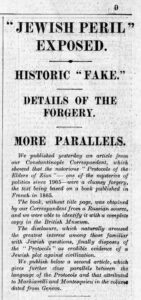This Month in Jewish History: September
August 30, 2020 in General
By Tiarra Joslyn.

In this August 17, 1921 London Times article, reporter Philip Graves compared passages from Maurice Joly’s Dialogue in Hell Between Machiavelli and Montesquieu (1864) side-by-side with excerpts from Protocols in order to prove that Protocols was plagiarized. See a scan of the full article here.
Over the summer, British rapper Wiley faced backlash – including permanent bans from Facebook and Twitter – after he made several anti-Semitic tweets, which included common anti-Semitic tropes such as how Jewish people control business interests. Conspiracy theories about the Jewish people are nothing new; Jews have been used as scapegoats for many things over the centuries, blamed for everything from plague to famine to the crash of the stock market to plotting to take over the world. The latter of these false ideas was largely perpetuated by a fake anti-Semitic text called The Protocols of the Elders of Zion, which falsely claimed to describe a Jewish plan for global domination. The text was written mainly in the first person plural and the “protocols” for which the text is named include several generalizations and platitudes about how to take over the world by taking control of the media and financial institutions, changing the “traditional” social order, and so on. Unsurprisingly, it does not contain any specific details on how to accomplish the ideas presented and is largely plagiarized from multiple sources, including works of fiction. In a book about the bogus manuscript, political scientist Stephen Bronner of Rutgers University describes the text as “probably the most influential work of anti-Semitism ever written… What the Communist Manifesto is for Marxism, the fictitious Protocols is for anti-Semitism.”
First published in Russia in September 1903, the hoax publication was translated into several languages and spread internationally during the early 20th century. In the 1920s, industrialist Henry Ford published translated excerpts in his newspaper, The Dearborn Independent, and funded the printing of 500,000 English-language copies that were distributed throughout the United States. Although the British newspaper The Times and the German Frankfurter Zietung both exposed the propaganda as a hoax during the 1920s, some German school children were assigned the text as factual reading after the Nazis rose to power in 1933. Hitler even cites Protocols in Mein Kampf, using the fake text as “proof” of the alleged “Jewish conspiracy” for which the persecution of Jews was necessary as self-defense.
Although proven to be a literary forgery and hoax, Protocols continues to be widely available around the world, particularly in the Middle East and online. The 1988 charter of Hamas stated that Protocols embodied the “plan” of Zionists; the reference was not removed until a new covenant was issued by the terrorist organization in 2017. The fake publication is considered by some scholars to be the beginning of contemporary conspiracy theory literature, and ideas derived from Protocols have been used to fuel other conspiracy theories such as claims that the figures depicted in Protocols are a cover for the Illuminati, Freemasons, or even “extra-dimensional entities.”